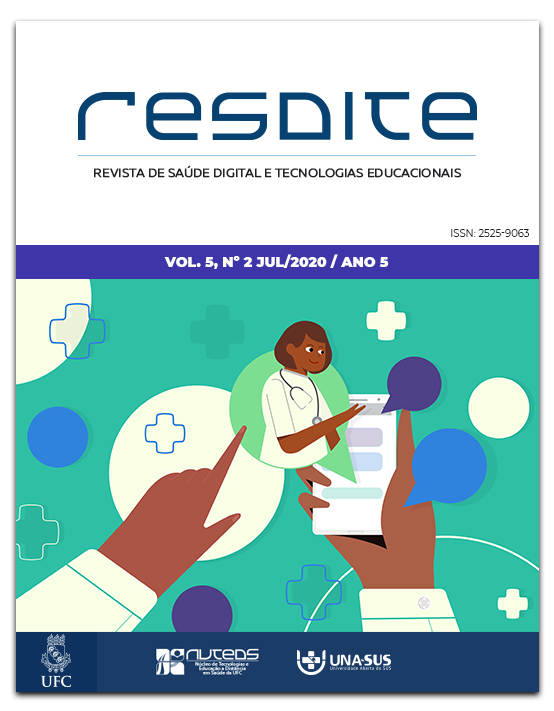A mobile app as an educational and motivational tool for adolescents in orthodontic practice
DOI:
https://doi.org/10.36517/resdite.v5.n2.2020.a1Palabras clave:
Orthodontic, Education, Mobile appResumen
Objective: To evaluate the acceptance of the mobile application (“app”) by adolescents in orthodontic treatment for a better applicability of this resource. Methods: Ninety orthodontic patients, aged between 13 and 17, of both sexes, used an application, chosen for presenting a Portuguese version and reaching the target audience. Then they registered their acceptance through the SUS (System Usability Scale) questionnaire, which measures user satisfaction through ease of use of the application, with its Satisfaction and Usability Indexes. The findings were subjected to descriptive and comparative statistical analysis using the Kruskal Wallis and Dunn test, adopting a significance level of 5%. Results: The application presented the above-average Satisfaction and Usability Index (79.1). The domain (quality component) with the highest index was "Learnability" (85,3), in relation to "Efficiency" (79,0), "Satisfaction" (76,0), "Memorability" (72,2) and "Errors" (71,4) (p≤0,05). Conclusion: Mobile app was accepted by adolescents in orthodontic treatment due to the ease and speed that it was used. However, its acceptance was negatively influenced by the reported frequency of use. Therefore, its application as an educational and motivational tool in clinical practice is suggested, as long as the different aspects that involve its best applicability are considered.
Descargas
Citas
Singh, P. Orthodontic apps for smartphones. Journal of Orthodontics 2013; 40 (3): 249-255.
Underwood B, Birdsall J, Kay E. The use of a mobile app to motivate evidence-based oral hygiene behaviour. British Dental Journal 2015; 219 (E2).
Kortum P, Sorber M. Measuring the Usability of Mobile Applications for Phones and Tablets. International Journal of Human-Computer Interaction 2015; 31 (8): 518-529.
Tiffany B, Blasi P, Catz SL, McCluree JB. Mobile Apps for Oral Health Promotion: Content Review and Heuristic Usability Analysis. JMIR Mhealth Uhealth 2018; 6 (9): e11432.
Chan A, Kow R, Cheng JK. Adolescents’ perceptions on smartphone applications (apps) for health management. Journal of Mobile Technology In Medicine 2017; 6 (2): 47-55.
Baheti MJ, Toshniwal N. Orthodontic apps at fingertips. Progress in Orthodontics 2014; 15 (36).
Zotti F, Dalessandri D, Salgarello S, Piancino M, Bonetti S, Visconti L, Paganelli C. Usefulness of an app in improving oral hygiene compliance in adolescente orthodontic patients. Angle Orthodontist 2016; 86 (1): 101-107.
Scheerman JFM, van Empelen P, van Loveren C, van Meijel B. A Mobile App (White Teeth) to promote good oral behavior among dutch adolescents with fixed orthodontic appliances: intervention mapping approach. JMIR Mhealth Uhealth 2018; 6 (8):163.
Grindrod KH, Hengartner U, Ong S, Logan AG, Vogel D, Gebotys R, Yang J. Evaluating authentication options for mobile health applications in younger and older adults. PLoS ONE 2018; 13 (1).
Henzell M, Knight A, Antoun JS, Fareella M. Social media use by orthodontic patients. New Zealand Dental Journal 2013; 109 (4): 130-3.
Li, X., Xu, ZR, Tang, N, Ye C, Zhu X, Zhou T, Zhao ZH. Effect of intervention using a messaging app on compliance and duration of treatment in orthodontic patients. Clinical Oral Investigations 2016; 20 (8): 1849–1859.
Wright NS; Fleming PS; Sharma PK; Battageld J. Influence of Supplemental Written Information on Adolescent Anxiety, Motivation and Compliance in Early Orthodontic Treatment. Angle Orthodontist 2010; 80 (2): 329-335.
Al-Silwadi FM, Gill DS, Petrie A, Cunningham SJ. Effect of social media in improving knowledge among patients having fixed appliance orthodontic treatment: A single-center randomized controlled trial. American Journal of Orthodontics and Dentofacial Orthopedics 2015; 148 (2), 231-237.
Aljabaa A, McDonaldb F, Newton JT. A systematic review of randomized controlled trials of interventions to improve adherence among orthodontic patients aged 12 to 18. The Angle Orthodontist 2015; 85 (2): 305-313.
Tantawi ME, Bakhurji E, Al-Ansari A, AlSubaie A, Al Subaie HÁ, A AlAli. Indicators of adolescents’ preference to receive oral health information using social media. Acta Odontologica Scandinavica 2019; 77 (3): 213-218.
Lodha S, Mehta S, Agarwal R. A “Smart” Elastics Reminder. JCO - Journal of Clinical Orthodontics 2014; 48 (3):180.
Alkadhi OH, Zahid MN, Almanea RS, Althaqeb HK, Alharbi TH, Ajwa NM. The effect of using mobile applications for improving oral hygiene in patients with orthodontic fixed appliances: a randomised controlled trial. Journal of Orthodontics 2017; 44 (3): 157-163.
Peres SC, Pham t, Phillips R. Validation of the system usability scale (sus): SUS in the wild. SAGE Journals 2013; 57 (1): 192-196.
Brooke J. SUS: A Retrospective. JUS - Journal of Usability Studies 2013; 8 (2): 29-40.
Sousa P, Fonseca H, Gaspar P, Gaspar F. Usability of an internet-based platform (Next.Step) for adolescent weight management. J Pediatric (Rio J). 2015; 91: 68-74.
Nielsen J. Usability 101: introduction to usability 2003. Disponível em <http://www.useit.com/alertbox/20030825.html>. Acesso em: 27 set. 2016.
Bangor A, Kortum P, Miller J. Determining What Individual SUS Scores Mean: Adding na Adjective Rating Scale. JUS - Journal Of Usability Studies 2009 maio; 4 (3):114-123.
Tenorio JM, Sdepanian VL, Pisa IT, Cohrs FM, Marin HF. Desenvolvimento e Avaliação de um Protocolo Eletrônico para Atendimento e Monitoramento do Paciente com Doença Celíaca. RITA 2010; 17 (2): 210-220.
Peng W, Kanthawala S, Yuan S, Hussain SA. A qualitative study of user perceptions of mobile health apps. BMC Public Health 2016; 16(1): 1-11.
Daniels AS, Seacat JD, Inglehart MR. Orthodontic treatment motivation and cooperation: A cross-sectional analysis of adolescent patients’ and parents’ responses. American Journal of Orthodontics and Dentofacial Orthopedics 2009; 136 (6): 780-7.
Descargas
Publicado
Número
Sección
Licencia
Os originais aceitos e publicados tornam-se propriedade da Revista Brasileira de Tecnologias Educacionais em Saúde. A revista adota a Licença Creative Commons, CC BY-NC. É possível acessar, baixar (download), copiar, imprimir, compartilhar e distribuir os artigos publicados conosco, desde que para uso não comercial, mencionando a RESDITE e atribuindo os créditos de autoria. A revista permite que os autores distribuam a versão do trabalho publicada conosco (ex.: em repositórios institucionais), desde que seja reconhecida a autoria e a publicação inicial na RESDITE.

